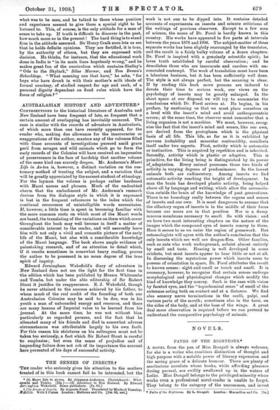THE SENSES OF INSECTS-t
"-THE reader who seriously gives his attention to the matters -treated of in this book cannot fail to be interested, but the • (1) Maori Life in do-tea. By Johannes Anderson. Christchurch Whit. .tombe and Tombs. [1.5s. J—(2) Adventure in New Zealand. By Edward Jerningliain Wakefield. Same publishers. [7s. 6d.] t The Senses of Insects. By Auguste Forel. Translated by Macleod Yearsley, .7.8.0.13. With 2 Plates. London ; Methuen and Co. [10a. 6d. net.]
work is not one to be dipped into. It contains detailed accounts of experiments on insects and minute criticisms of the writings of previous observers. Except to a few men of science, the name of Dr. Forel is hardly known in this country. His works have appeared in five parts at intervals between the years 1878 and 1906. The subject-matter of these separate works has been slightly rearranged by the translator, and the result is a fairly bulky volume of a dozen chapters. Dr. Forel is inspired with a genuinely scientific spirit ; he loves truth established by careful observation; and he demolishes those who are inaccurate and careless with un- concealed contempt. The work of translation must have been a laborious business, but it has been sufficiently well done. The style is not always perfect, but the meaning is clear. If by reading this book more persons are induced to devote their time to serious work, our views on the psychology of insects may be greatly enlarged. In the short space at our disposal we will try to summarise the conclusions which Dr. Forel arrives at. He begins, in his preface, by cautioning us that we must place ourselves on a level with the insect's mind and avoid anthropocentric errors; at the same time, the observer must remember that a living organism is not a machine. We must, however, recog- nise the fact that the insect's mind and senses, like our own, are derived from the protoplasm which is the physical basis of all life. This life, so far as it is exhibited by nervous irritability and muscular contractility, manifests itself under two aspects. First, activity which is automatic or instinctive. This is acquired by repetition and is inherited. Secondly, activity which is plastic or adaptive. This is primitive, for the living being is distinguished by its power of adaptation. Every animal possesses these two kinds of activity in varying degrees of predominance. In the lowest animals both are rudimentary. Among insects we find automatic activity reaching the height of development. In man the brain has developed plastic activity, being helped above all by language and writing, which allow the accumula- tion outside the brain of the knowledge of past generations. There is no homology really between the organs and senses of insects and our own. It is most dangerous to assume that the olfactory organ of insects is in the middle of their faces because our noses are in that position Nor is a damp mucous membrane necessary to smell. So with vision : and we have two most interesting chapters on the nature of the images which the compound eyes of insects convey to them. Here it seems to us we enter the region of guesswork. But entomologists will agree with the author's conclusion that the only insects which see well are dragon-flies. Other families, such as ants who work underground, subsist almost entirely by smell and taste. Hearing is well developed in some crickets, but most insects appear to hear little or not at all. In discussing the mysterious power which insects seem to possess of orientation in space, Dr. Forel attributes the result to known senses : sight and smell or touch and smell. It is necessary, however, to recognise that certain senses undergo morphological and physiological changes which modify the kind of knowledge they convey. Such is the case with vision by faceted eyes, and the " topochemical sense" of smell of the antennae acting both on contact and at a distance. We find also sensory nerve terminations in the ocelli, palpi, and various parts of the mouth; sometimes also in the tarsi, on the sides of the body, and at the base of the wings. A great deal more observation is required before we can pretend to understand the comparative psychology of animals.














































 Previous page
Previous page